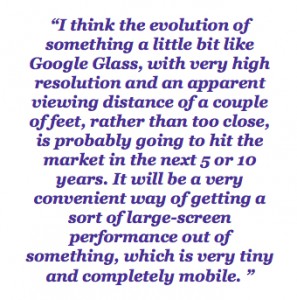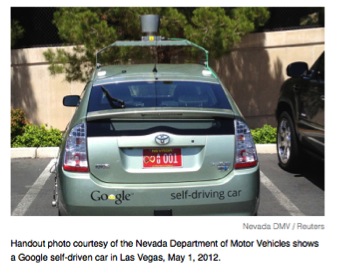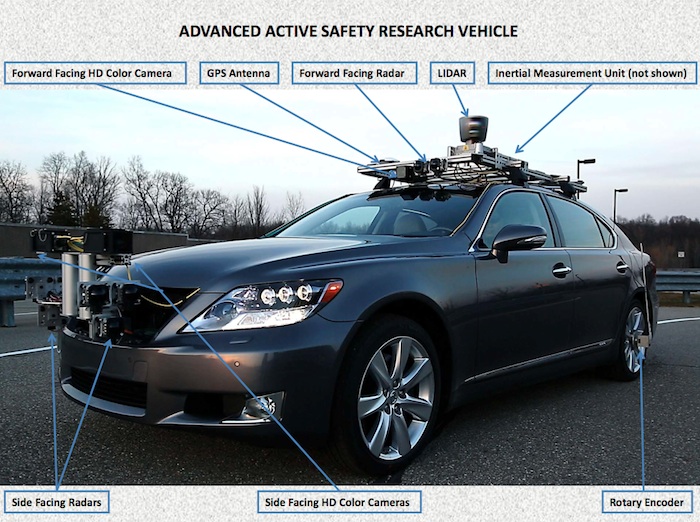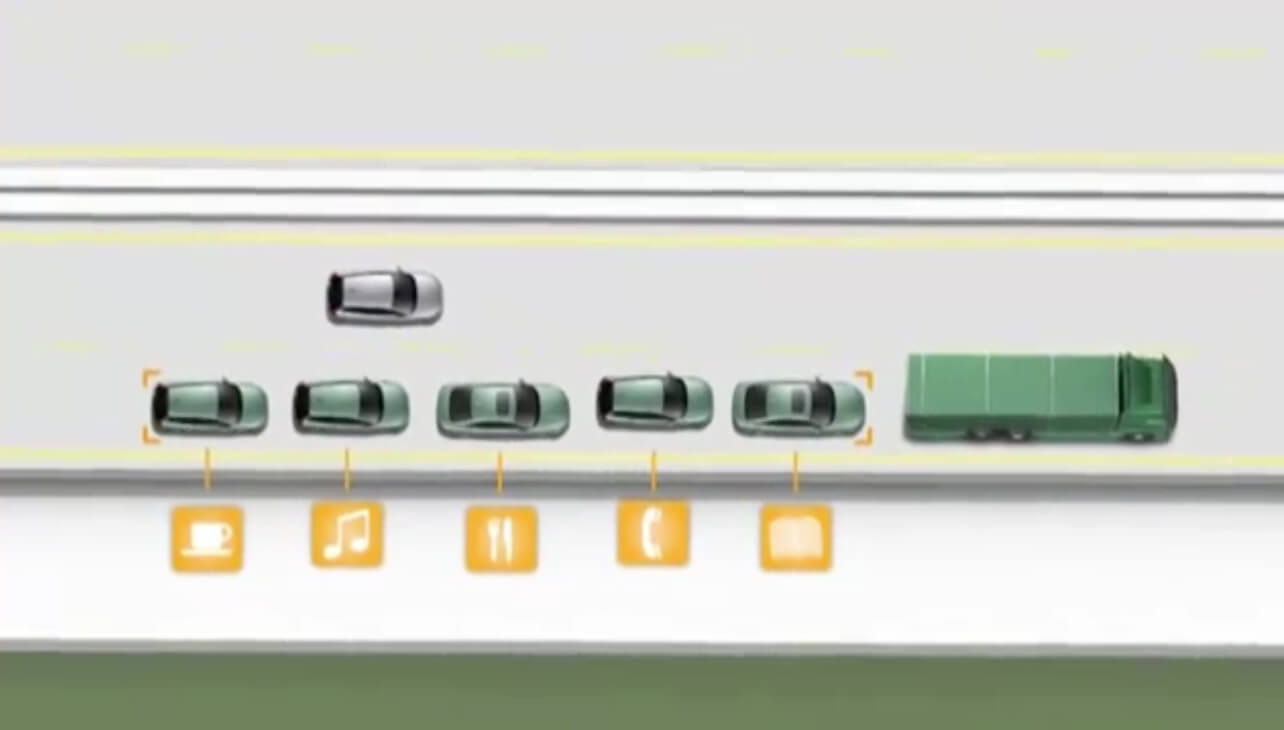New Form Factors for Computing Devices and Displays, Holograms, Automotive Interfaces, Driverless Cars and Platooning Robot Cars
 In this Future Tech interview, Shara Evans is speaking with Dr Dean Economou who guides NICTA research and development for impact in the Digital Economy, Broadband Applications, Transport, Infrastructure and Logistics. He was former head of CSIRO’s Networking Lab, an architect of the Smart Services Cooperative Research Centre (CRC) and developed core technology for the IEEE802.6 standard. Dean is also currently Business Development Director for Yuruware, a NICTA cloud tools start up.
In this Future Tech interview, Shara Evans is speaking with Dr Dean Economou who guides NICTA research and development for impact in the Digital Economy, Broadband Applications, Transport, Infrastructure and Logistics. He was former head of CSIRO’s Networking Lab, an architect of the Smart Services Cooperative Research Centre (CRC) and developed core technology for the IEEE802.6 standard. Dean is also currently Business Development Director for Yuruware, a NICTA cloud tools start up.
Shara Evans (SE): Today, it’s my pleasure to be speaking with I’m speaking with Dr Dean Economou from NICTA. Dean is a technology strategist, with a very long and illustrious background in working for top research organisations, including CSIRO, where he was the director of CSIRO’s Networking Technology Lab and the Smart Internet Technology CRC, as well as joining NICTA in 2008.
Today, Dean and I are going to talk about what the telecoms world is going to look like in 10 years’ time — that is, the year 2024 — from a technology and services perspective. But to get to the future, we need to start looking at some of the trends that are happening today.
Dean, let’s start with some of your observations on computing devices and, in particular, tablets.
New Form Factors for Computing Devices and Displays
Dean Economou (DE): Shara, I think we are in very, very interesting times. It’s a little bit like a period in evolution when there are millions of sea creatures, all trying to work at the right niche. If you look at the format of the computing devices we have, we’ve got traditional laptops, which have almost completely replaced desktop PCs. At the other end, we’ve got wearable devices; we’ve got normal-sized mobile phones; we have these intermediate large mobile phones called phablets; and now we have tablets as well. It seems like the market is trying to find what people find most useful, and it’s probable that there are many different types of people with different kinds of needs, and maybe there’s a place for all of these different form factors.
SE: Well, what do you think we might be using in 10 years’ time? Can you cast your mind that far?
 DE: Well, actually, as I talk to you, Shara, I’m using one of these Microsoft Surface devices. It’s the generation 2 of it. This is a very interesting little device to me. It’s in the form factor of a tablet. It’s a bit chunky and it’s a bit heavy, but, nevertheless, it is a tablet and it’s quite functional without a keyboard, but the thing is a fully fledged PC that runs full Windows, can drive big screens and all the usual protocols. It’s dual-core i5. This particular model’s got half a terabyte of solid-state storage as well, and it runs for seven hours off batteries. It really is a combination of a tablet and a PC, and without the keyboard. I could use it if I have to, but if I want to, I could click in a little keyboard.
DE: Well, actually, as I talk to you, Shara, I’m using one of these Microsoft Surface devices. It’s the generation 2 of it. This is a very interesting little device to me. It’s in the form factor of a tablet. It’s a bit chunky and it’s a bit heavy, but, nevertheless, it is a tablet and it’s quite functional without a keyboard, but the thing is a fully fledged PC that runs full Windows, can drive big screens and all the usual protocols. It’s dual-core i5. This particular model’s got half a terabyte of solid-state storage as well, and it runs for seven hours off batteries. It really is a combination of a tablet and a PC, and without the keyboard. I could use it if I have to, but if I want to, I could click in a little keyboard.
So I think some evolution of a device like this, which obviously is going to get a lot thinner and smaller with time, looks like a very good portable compromise. I think when you need to create documents, as you and I do, you do need to have a very large screen. It’s actually extremely important. I think these devices need to be really good and handy at connecting into very large screens — a window to the desktop environment. But having something on the go that you can edit with and is very tiny and has the full power of a PC, I think, is really compelling.
SE: Dean, it’s interesting that you talk about big screens. I feel absolutely useless without my 30-inch monitor. But I’m thinking about some of the holographic technology that we’ve seen displayed in research labs that’s perhaps used for both the keyboard, as well as the display. Do you think we’re likely to see this in tablets or computers in 10 years’ time?
 DE: It’s very interesting, Shara. As you know, in our CSIRO days, we were looking at holograms and immersive three-dimensional environments. Actually getting holograms, proper holograms, to display high detail in a small device in a reasonable amount of time, I think, is still quite a way off — but technically possible in the lab.
DE: It’s very interesting, Shara. As you know, in our CSIRO days, we were looking at holograms and immersive three-dimensional environments. Actually getting holograms, proper holograms, to display high detail in a small device in a reasonable amount of time, I think, is still quite a way off — but technically possible in the lab.
Possibly what’s more likely, I think, is the glasses technology where, with the right kind of optics, we can make very tiny high-quality displays. So if you just get some glasses, you can actually have the effect of a large screen, which appears to be a fair distance away. I don’t think it really needs to be 3D. Rather, I think you probably noticed, when you have very high-resolution screens, you get the effect of 3D even though there’s only one image coming at you.
I think the evolution of something a little bit like Google Glass, with very high resolution and an apparent viewing distance of a couple of feet, rather than too close, is probably going to hit the market in the next 5 or 10 years. It will be a very convenient way of getting a sort of large-screen performance out of something, which is very tiny and completely mobile.
SE: That would be a really interesting gadget to have, and I suppose what users would have to become accustomed to is in how to distinguish between their virtual display and what’s really happening in front of them. It’s going to require a bit of an experimentation stage before that sort of technology is widely adopted, but Google Glass is quite an interesting gadget, and I’d love to talk more about that a little bit later.
Just going back to the keyboard interface, do you see a time when we won’t need a keyboard or when keyboards might be projected in a similar way that the display would be projected?
I don’t know about you, but when it comes to working on big documents or spreadsheets, there’s no way that I want to do it with just a swipe pad. I really do need to use all of my fingers.
DE: Yes. I think that we’re still at a time we’re trying to understand what the best interface is for these mobile computing devices. So, if you’re creating documents, I still think the keyboard is king. Most people I know really find that they’re not as accurate unless there’s some kind of tactile feedback, so typing on glass has liberated an enormous amount of functionality in small devices, but if you have to create documents, you still need a physical keyboard. Now that’s one very particular use case. If you work in an office, or you write articles, or you create structured documents, I think you really need access to a keyboard somehow that’s a good-quality one.
Automotive Interfaces
But our interfaces to computers now are much more general. What I find fascinating is use in a vehicle. Really, a keyboard is a terrible interface inside a vehicle, and a touch screen is also a terrible interface inside a vehicle. You have to be extremely careful not to distract people. So we’ve seen that audio and head-up displays, some combination of those, will be probably the most effective things in vehicles.
I would also say that you need the vehicle to have an awareness of the driving complexity around you. In complex driving situations, you really shouldn’t be doing anything except paying attention to the road, unless you have a car, which can do that for you, which is also something that’s coming.
SE: Well, it’s actually quite interesting that you spoke about interfaces in cars because one of the questions I was going to pose to you has to do with audio interfaces.
 Siri on Apple phones and tablets is an interesting new paradigm, but I still think there is a lot of work to go in those types of interfaces, particularly with correctly recognizing voice: people with different accents and different ways of pronouncing things.
Siri on Apple phones and tablets is an interesting new paradigm, but I still think there is a lot of work to go in those types of interfaces, particularly with correctly recognizing voice: people with different accents and different ways of pronouncing things.
It’s still a bit distracting, but I can imagine a future where an audio interface would be very, very useful, especially in a situation when you can’t look at the display.
What are your views on the audio interface for smart phones and tablets and, in particular, in cars? What do you imagine we might be seeing in, say, 5 years’ time or 10 years’ time?
DE: Okay. So I like to think about what technology means rather than what it is at the moment. Trying to understand the whole length of accents and different people speaking out of the box, without training the software, is actually a very hard job. The technology’s taken leaps and bounds in the last 5 years, so I would say that 10 years from now, I think we’ll have extremely accurate, very natural voice recognition, which I think will make it a pleasure to interact with our computing devices, especially in vehicles.
 Vehicles are hard because there’s a lot of noise as well. Even quiet vehicles have a lot of noise, so it’s a particularly challenging environment. But if people really want speech recognition to work, at the moment it can work extremely well, but you will need to put the time into training. Interfaces like Siri and Google don’t really have the resources to do billions-of-people training, but that will come and the software will get better. I think that audio interfaces in computing devices are incredibly important, and I think it’s still somewhat under utilised, and I hope to see it get a lot better.
Vehicles are hard because there’s a lot of noise as well. Even quiet vehicles have a lot of noise, so it’s a particularly challenging environment. But if people really want speech recognition to work, at the moment it can work extremely well, but you will need to put the time into training. Interfaces like Siri and Google don’t really have the resources to do billions-of-people training, but that will come and the software will get better. I think that audio interfaces in computing devices are incredibly important, and I think it’s still somewhat under utilised, and I hope to see it get a lot better.
SE: I’m sure it will. I would imagine that there is big money in it somewhere down the line, and where there’s money, there’s innovation and people willing to invest.
In thinking about cars and transportation in general, it seems that there is a lot of work happening in the automotive and logistics industry in the technology space. For example, a lot of manufacturers are looking to incorporate increasing numbers of sensors and other devices within a vehicle. At the present stage, and knowing that you’ve done work in this area, I’d like you to share your views on what the future might hold in this space.
DE: Again, that’s a very interesting question. What we’re finding and the more we understand about the way human perception and processing takes place when we’re driving, the more we realise that anything which takes a human mind off the task is a very bad idea. It doesn’t matter if you’re talking to someone in the car or you’re trying to use the stereo in the car, using a mobile phone, whatever it is — all of these tasks are distracting you. I think ultimately what it comes down to is that humans are just not very good machines for driving consistently.
Driverless Cars
We were at the Intelligent Transport Systems World Congress in Tokyo last year, and, really, every major manufacturer now has got a program in extremely advanced safety. The endpoint of every manufacturer’s roadmap is autonomous vehicles, which can’t crash because they’re robots. Those machines have many perceptual systems — multiple cameras, laser systems, radar systems, and a whole bunch of algorithms that do lots of calculations to make sure that at least the vehicles are not going to be the reason you crash.
SE: But for that to happen, Dean, would there need to be sensors laid out along roadways as well as within the car?
DE: It’s a good question, Shara. There two parallel approaches. One is where the vehicles — using digital short-range communication (DSRC) — transmit information about their dynamic behaviour to each other and also the infrastructure, so the road knows what the cars are doing; the cars know that the road’s changing traffic lights; or that there are blind corners coming up, and so forth. The idea there is that if all the systems are aware of each other and what they’re doing, that you can do something to minimise collisions.
 For example, if you were approaching an intersection in a built-up city and you couldn’t see around the corner, the radio system can see around the corner. The car would know that someone doesn’t stop at the red light and not let you through, for example. In that case, the vehicle safety system would take over from the human driver if it thinks there’s going to be an accident. In a sense, this is an extension of ABS braking systems, stability control systems. It’s the next step. So it’s like coordinated safety systems.
For example, if you were approaching an intersection in a built-up city and you couldn’t see around the corner, the radio system can see around the corner. The car would know that someone doesn’t stop at the red light and not let you through, for example. In that case, the vehicle safety system would take over from the human driver if it thinks there’s going to be an accident. In a sense, this is an extension of ABS braking systems, stability control systems. It’s the next step. So it’s like coordinated safety systems.
The parallel approach — and in fact vehicle manufacturers are doing all of these things — is you can’t rely on other vehicles being set up like that because it will take 25 years for this to happen. So, in the interim, you basically make cars into robots, which sense everything. Modern vehicles, everything from Mazda to Mercedes, now, the advanced ones basically have a system that will put on the brakes if it sees something in front of you and you’re not stopping. You’ve got intelligent cruise control that can track the car in front of you. A lot of vehicles can actually follow lines on an Autobahn or a motorway.
Not even terribly expensive cars are effectively driving themselves now in very limited situations. Over time, what we’ll see is the situations where the cars are competent to drive themselves will increase. You’ve already seen states like Nevada — Nevada’s the one I know of — possibly New Mexico and I think Washington State have introduced special conditions where vehicles could drive autonomously legally under certain situations. The legislation is starting to be put together.
SE: Wow. It’s hard to believe it’s already happening. I knew there were a lot of experiments in this place, but I didn’t realise that one could do it outside of very controlled conditions. When do you think something like this is going to be commonplace? Could it be as soon as 10 years from now or sooner?
DE: I think this is — what we’ve noticed in the last five years in that industry is that it’s happened faster than anyone thought. I think the advances in electronics and computation, the mass production of some of these sensor systems, has meant that the basic hardware to do the functions now is really cheap enough for mass deployment. What we’re doing is working out the functions and the software and all the possible interactions. You know, the range of driving conditions humans deal with is very complex.
SE: It’s going to be a very interesting space, and I would imagine that there’d have to be some kind of management systems or perhaps services that companies would offer to be able to control the traffic. What are your thoughts here?
DE: Well, controlling traffic is an interesting one. We’re going to get to the point where the roads are actually full.
SE: If you look at science-fiction movies, you can see these lines of futuristic cars evenly spaced along the roads, and when they get to the intersection, they all just manage to seamlessly crisscross without red lights and just keep going. Do you think something like that is possible in the near future?
Platooning Robot Cars
DE: Well, parts of that are already happening. In some of these intelligent-systems trials, they’re talking about things like platooning, and what they’re imagining is on a freeway, you might have a dedicated lane where only robot cars can use that lane. You can have a robot car and oddly 50 vehicles travelling in a platoon. They’re all under robot cars. There’s a lead car travelling, which has got maybe an expert driver in it. They’re going at 150 Km because it’s safe at that speed. What happens is you join a platoon, and the cars will sit very close behind each other, and there are these electronic machines keeping them at a safe distance. They all know what the others are doing and are sending out precautions to each other. Of course, that way, you can massively increase the density of the vehicles on the road.
In terms of traffic capacity, there was this stat that came out, I think by the Ford Motor group, and they said, “By 2040, imagine a world with 5 billion cars.”
SE: Oh, boy.
DE: Yes, I know. The current growth rates in emerging economies is huge — we’re looking at a planet where one person in two has got a car. If you think about it, that’s just not going to work. But even long before you get to that, you get to the point where there’s no room left on the road for everyone who wants to drive at the same time.
SE: Dean, when do you think we might see platooning? I’ve never heard that term used for vehicles. Is this something that you think might be in the near-term future, or is this further out? If you had to put a timeline on it, what would your feeling be?
DE: They’ve already demonstrated it in limited trials, so it’s technically very possible. I would think, again, it’s a five- to ten-year thing. Probably more importantly, I think we need to look at how we do demand management on traffic to make sure we do something about keeping the roads uncongested. That’s one the great challenges over the next 20 years.
SE: I think many in the public transport sector would agree with you there, but that’s a whole different topic.
We’ll be publishing Part 2 of the interview with Dean Economou on Friday 18 April – where we will discuss crowd sourced traffic information, automotive communications control systems, sensor networks, wearable and ingestible devices, innovations in healthcare early detection systems and drones.




“I would imagine that there’d have to be some kind of management systems or perhaps services that companies would offer to be able to control the traffic”, this thought jumped out at me as being particularly scary. It implies that one way of limiting over crowding on our roads will be to keep the poor off them. Presumably everyone will be ‘allowed’ to use the roads, but if you can’t afford a premium ‘traffic management service’ you will be ‘managed’ to the slow lane.
David, thank you for your comment!
When I posed this question, I was thinking of the communications network and signalling that would be required for traffic management – but your comment reinforces the potential dark side of any technological advance. In the wrong hands, it can be used for great social harm.